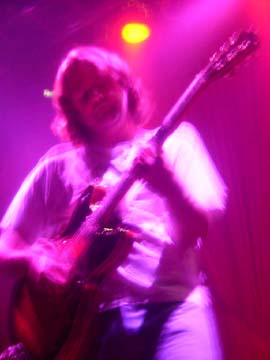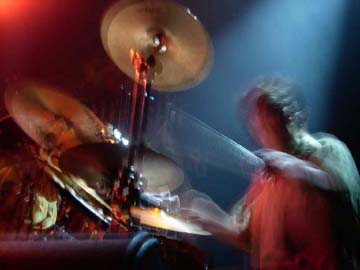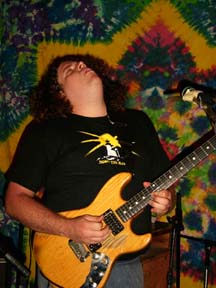
Music Freaks
 |
Hippies, punks and ravers are doing a new jamband twist on the old psychedelic dance floor
by Lee Abraham
Origins of the term "Jam Band" are murky. -When- the jamband scene started is less of mystery. Jerry Garcia’s death in ’95 brought the demise of the Grateful Dead’s record breaking concert tours. Suddenly, thousands of music freaks who followed the Dead had nowhere to go. Or so it seemed. When deadheads were forced to seek musical alternatives to continue the touring lifestyle they had grown to love, a new jamband twist on the old psychedelic dance floor was waiting to greet them.
The ‘post Garcia era’ brought new interest in previously overlooked local and regional bands. More people were coming to gigs. A once dormant camping and music festival summer circuit mushroomed on the East coast - a key component of the jamband scene’s sense of community and ultimately the grassroots benchmark of its vitality. Prior to ‘95, a bumper crop of new bands had already emerged. Although these bands spanned an array of musical styles, they all shared one thing - they ‘jammed.’ Songs were adventures. Concerts an experience. Tours - a way of life.
Fans searched for a way to describe this exciting brand of improvisational music. "Groove Music," "Kind Tunes," and "Jam Rock," were typical lingo. The debate was officially put to rest in ‘98, when Dean Budnick published -Jam Bands, North America’s Hottest Live Groups-. Forget about a name, suddenly the scene had a bible. In addition to the book, Budnick also started -Jambands.com-, a monthly online ‘zine. The combination was potent. The book gave the scene a solid foundation to build on, while the website became the forum for it to find its identity. Jambands.com fostered the sense of community that started at the festivals. By bringing together many of the best music writers from around the country, inviting contributions from fans and utilizing a team of regional contributing editors, the website was well written and informative. It was also an instant success.
--------Children of the Dead?----
The Grateful Dead didn’t invent jamming, yet they will always be regarded as the premier, "first generation," jamband. Then came Phish and Widespread Panic. Both are now at the top of the scene’s second generation. The third generation is a crowded field. Ekoostic Hookah, the Ominous Seapods, Keller Williams, the Disco Biscuits, Strangefolk, Big Wu, Jiggle the Handle, and Wise Monkey Orchestra, and many others, are all attracting nationwide fan bases. And none of them sound like the Dead.
 |
JB of Widespread Panic
"Jambands are often related to the Dead by the media," says Lee Crumpton, "because the Dead are a well known example of a group whose music was heavily based on improvisation." Crumpton is the founder of the Home Grown Music Network, an artist collective that helps independent bands pool resources for everything from touring to marketing CDs. A typical jamfan, Crumpton is passionate about the music: "Each night they give their fans something new and unique, it keeps them interested and coming back for more. It can be very spiritual."
That spirituality beats from the same day-glo heart that remains the pulse of the Grateful Dead’s community of fans. No question about it. That’s not selling jambands short for originality or artistic merit, although many jambands resist any connection to the Dead. Or the jamband label itself. Too much burnt-out-old-hippie baggage for some. Understandable. Younger brothers and sisters usually resist comparison to older siblings. But the bottom line in both scenes is the same - transcendence of the human experience through music, -together- with a community of like minded folks enjoying the same cosmic buzz.
That doesn’t mean the people are the same. Or the music. "It’s more of an approach than a genre," says Rudy Jalio, owner of Legends Lounge, a popular stage for jambands touring between California and all points East. "It really doesn’t matter what style... it could be jazz, bluegrass, rock, whatever. The point is that they want to take the instrumental part of the song and extend it to go on an improvised musical journey. Bands like the Disco Biscuits and Sector 9 are even taking the whole thing to a new level by introducing some newer influences, techno type stuff."
 |
Zack Velmer of Sector 9
--------Punks, Hippies and Brand Name Shopping-----
"The punk world had a very strong internal support system which the jamband scene is just beginning to develop," says Seth Goldberger of Lauan Records. "A plethora of independent labels exist in that community whose mission is to support their scene." Example - Dischord Records, a grass roots label with the sole purpose of promoting punk bands. "Dischord developed its own fan base," says Goldberger. "People would get to know the Dischord ‘sound.’ As a result, fans would buy new albums from new bands simply because Dischord released them."
Hydrophonics Records, founded by Johnny Z, the heavy metal biz wiz who made Metalica a star, banked on the scene early, releasing albums from Juggling Suns, the Disco Biscuits and the Ominous Seapods. Lauan broke new ground releasing Day By the River’s, -Watermarks-, the "first full length mp3 CD." There’s more. On a mission to "Save the World From Mediocre Music," the Phoenix Rising label has released both live and studio material from Jiggle the Handle, Foxtrot Zulu, and Blueground Undergrass, among others. Mammoth Records will soon release a new album from Strangefolk. Upstate New York pioneers, moe., recently begged out of deal with Sony after releasing two records to go the same do-it-yourself route also being blazed by Rocky mountain jamgrass masters, the String Cheese Incident.
 |
Gary Backstrom of Jiggle the Handle
And then there’s the HGMN. Although it has only released three compilation CDs showcasing the music of its members, the HGMN has achieved Dischord style brand name recognition. Part of the reason - good business. Twice a year, 60,000 free catalogs with info on its 50+ members are mailed out and distributed by volunteers. Band info and online radio programs featuring new music are posted on their website. While the HGMN’s marketing arm helps bands keep the cash flowing, HGMN membership also helps book gigs in new locations. Only 10 percent of the bands that apply to the HGMN are invited to join. Being selective has reaped dividends. "Because there are so many bands, they act as sort of a quality control filter," explains Jalio. "As the owner of a club that books touring bands all the time, I’m contacted daily by bands that I’ve never heard of. If a band tells me that they’re in the network I’ll book ‘em every time. It’s as simple as that."
----------Nothing to rave about, the local jam scene---------
When the Grateful Dead sold out a two day run in ’91 at the Sam Boyd Silver Bowl, breaking the record for the largest live event in Nevada’s history, local government and casino types were shocked. And mortified. But by the time the Dead pulled out of town for the last time in ‘95, after five oh-so-lucrative years of cashing in on their huge, and in their eyes, unsavory following, those same snobbish politicians and gaming bigwigs were singing a strange and different tune.
Vegas was jamband central when the Dead were in town, but in their absence the jam was scarce. Then, as East coast jambands explored the West, they discovered Legends. A natural stop enroute to, or from California, Las Vegas is a 24 hour, high octane adventure gig that fills the fear and loathing quotient of any band’s cross country trek. Traveling bands love to party in the neon city. Locals are more finicky. "Right now it seems that the club scene in Vegas is dominating," says Jalio. "The hippie type people that are almost on a parallel universe, people that would be drawn to this type music, are going to raves."
"I feel like the last year was an educational year," continues Jalio. "We’ve brought in so many bands with so many new names, that unless you’re a hard core fan, it’s hard to keep up with this stuff." To battle the steep learning curve, Jalio and his fellow ‘hardcores’ have started the -LasVegas Jam Band Society-. "The goal is to increase awareness of what’s going on and to insure that this style of music continues to grow on a local level," says Jalio.
There’s reason for hope. A few new bands are popping up which may give the local scene something its never had - a community of -local- jambands. - Relapse- and -Morning Wood- are two, young bands mixing originals with jammy covers. Together with -Ground Luminosity-, the new project of Steve McCoy, from old school Vegas jamband -Soul Festival-, all three are giving local jamfans something to smile about. "We are definitely a point in the traveling routes of the bands getting from East to West," says Jalio. "Hopefully by pairing the local bands on those bills, we’ll get something going. Don’t kid yourself though, this is a long term growth situation."